Classical Music in Geneva, Part 1
John Marks, Curator of Collections and Exhibits
Since Geneva’s founding, classical music has been part of the village. I struggle with the term “classical.” I don’t think it describes music any better than “farm house” describes architecture. I’ve seen all types of houses on farms, from small mansions to ranch houses. In the interest of harmony (pun slightly intended) I will defer to the Wikipedia.com definition. “Classical music is art music produced or rooted in the traditions of Western music, including both liturgical (religious) and secular music. While a more accurate term is also used to refer to the period from 1750 to 1820 (the Classical period), [it can refer to] the broad span of time from roughly the 11th century to the present day, which includes the Classical period and various other periods.”

Newspaper ad for music lessons by Mrs. Nixon, 1825.
I wish newspapers and diaries told what music was played by whom on what instruments, but they rarely do. At best we find advertisements for music lessons or for music as part of private school curriculum. We have a general idea of what kind of music was associated with young ladies and polite society. In 1824 Mrs. Nixon wasn’t teaching her pupils sea chanteys or bawdy tavern songs.
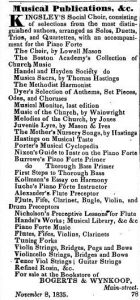
Ad for music books available at Bogerts & Wynkoop, 1835.
Bookstore advertisements tell us what was popular. The full title of Juvenile Lyre by Mason and Ives (written in 1831) was Hymns and songs, religious, moral, and cheerful, set to appropriate music. For the use of primary and common schools. “Mary Had a Little Lamb” first appeared in this book, although set to a different melody than the one we know.
While not everyone attended a church, religion was an important aspect of early Geneva life. Parishioners often attended several services a week and developed their social circles there. Prior to the first public halls, churches were the largest spaces for public gatherings. Music in churches, whether in or out of a religious service, was restricted to sacred selections. (I’ve written elsewhere that Jenny Lind wanted to sing in Geneva in 1851 but the Presbyterian Church wouldn’t let her perform secular selections.)
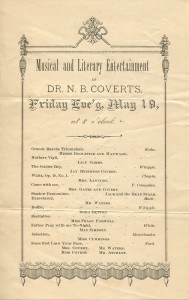
Program for Dr. N. B. Coverts, date unknown
Home entertainments were a chance for more variety. Not all of them had printed programs such as this one. In addition to classical pieces on the piano, a soloist or small group might sing art songs which were often poems set to music and presented at recitals.
Once the village had music halls and an opera house Geneva attracted internationally known musicians. The railroads were certainly a factor as Geneva was on both the Lehigh Valley and New York Central railroad lines. It had an upper class, educated population that would attend concerts, and there were a number of nearby towns from which to draw larger audiences. Many performers came to Geneva and most are no longer household name but I will focus on three people and their stories.
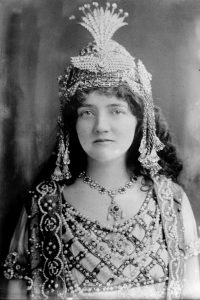
May Peterson, 1910
May Peterson (1880 – 1952) was an American soprano who joined the Metropolitan Opera Company in 1917. She debuted as Michaela in Carmen that same year. Like many vocalists she made concert tours when not appearing with the opera. She sang at the Smith Opera House in 1921. You can hear her recordings by clicking the link below: http://www.southwestern.edu/infoservices/departments/specialcollections/exhibits/peterson/Recordings.htm
Camille Urso (1840 – 1902) was a groundbreaking child prodigy. The violin was not considered a woman’s instrument, but her first public recital at the age of seven was a success. By twelve she was playing private and public concerts in New York City, followed by a tour of other major American cities. She had a long international career before retiring in New York in 1895.
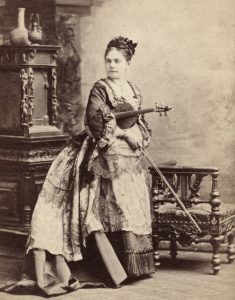
Camille Urso
Madame Urso performed at Collins Music Hall six years after retirement and only one year before her death. She may have come here as a favor to Walter Crabtree, the Trinity Episcopal Church organist who had moved here from New York. I have found numerous concerts that were sponsored by Mr. Crabtree involving city musicians. I don’t know that the violinist and organist were friends but her post-retirement recital seems unusual.
Albert Spalding (1888 – 1953) was born into a sporting family in Chicago. His Uncle Albert was a baseball Hall of Fame pitcher, and his father and uncle founded the A.G. Spalding sporting goods company. Young Albert went in another direction, studying the violin in New York and Europe. At the age of 18 he debuted in Paris and worked in Europe before joining the New York Symphony two years later.
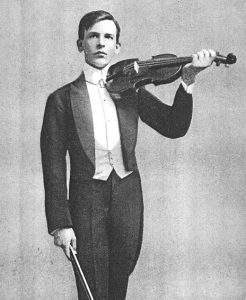
Albert Spalding
Mr. Spalding performed in February 1921 at the Smith Opera House. However, the performance that caught my attention was in 1944 while serving the United States government in Italy. According to Wikipedia, “Spalding gave a legendary concert to thousands of terrified refugees stranded in a cave near Naples during a bombing raid.” His recordings can be heard by clicking the link below: https://ccrma.stanford.edu/groups/edison/exhibit/exhibit-1.html
More soloists and orchestras performed in Geneva, to say nothing of many local groups that formed in the 20th century. I will continue the story next month.
